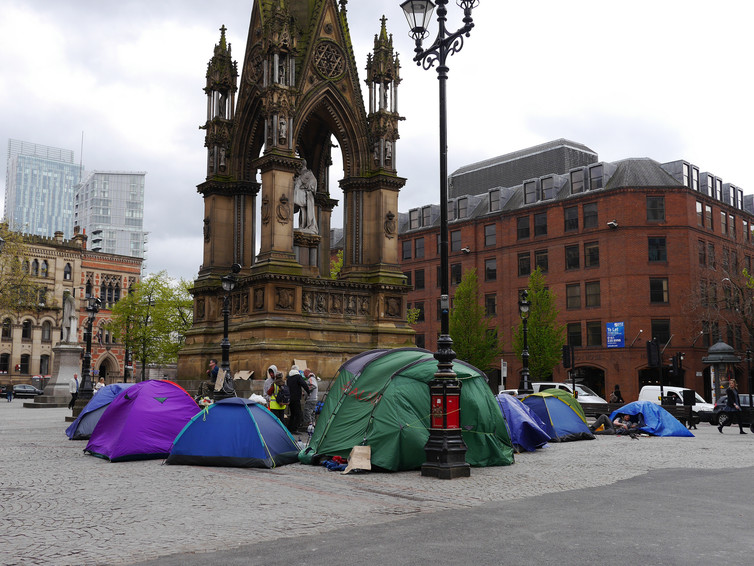In the first six months after a new law banned the sale and production of psychoactive substances in Britain, over 31 shops have been shut and four people convicted. But there are early indications that the law could actually be increasing the street market for synthetic cannabinoids – commonly known as “spice” – but at higher costs.
The main goal of the Psychoactive Substances Act, introduced at the end of May 2016, was to shut down shops and websites trading in psychoactive substances – formerly referred to as “legal highs”. The new law makes it an offence to produce, import or supply any psychoactive substance if it is likely to be used for its psychoactive effects, regardless of its potential for harm. Possession of a psychoactive substance is not an offence.
To enforce the Act, tough sentences for offenders were introduced, including up to seven years in prison for the supply, production, possession with intent to supply, importation or exportation of a psychoactive substance. New powers have also been given to the police, who can use prohibition and premise orders to shut down shops that sell drugs paraphernalia, known as headshops, and online dealers.
According to a press release from the Home Office at the end of December, since the Act came into force, the police have stopped 332 shops across the UK from selling psychoactive substances, and 31 headshops have closed down.
Spice for sale
From these figures, it would appear that the new Act is having the desired impact. But although the police may be stopping sales on the high street, as our research predicted before the introduction of the new law, the prevalence of synthetic cannabinoids – commonly known as “spice” – shows no sign of decreasing.
Our study – which is not yet publicly available – conducted in Manchester in early 2016, found that synthetic cannabinoids were by far the most commonly used psychoactive substances in the city. This was particularly the case among the homeless. As noted by one of those we interviewed for the study, synthetic cannabinoid use was “really rife” in the homeless community at the time the new law came into force, with an estimated 80 to 95% of the homeless in the city dependent synthetic cannabinoid users.
We found that the undetectable nature of synthetic cannabinoids (both in public spaces and in mandatory drug tests), their potency (when compared to skunk cannabis) and low cost – £10 for a 1.5g packet that could make up to 20 joints – made them particularly appealing for an economically disadvantaged group such as the homeless. These substances are also highly addictive, and many of those interviewed had replaced problematic use of other substances – typically heroin and crack cocaine – with just synthetic cannabinoids.
Regular users reported increased tolerance that led to many dependent synthetic cannabinoid users spending around £50 a day on their habit prior to the new law being introduced. So it was unsurprising that dependent users of synthetic cannabinoids were resorting to theft, begging and prostitution to fund their habit.
Prior to the new law, there was an already well-established street-level synthetic cannabinoid market in the area with users stockpiling them in preparation for the closure of shops selling psychoactive substances.
Market for homeless users
All of those we interviewed predicted that this market would simply increase following the implementation of the new law. As was the case in Ireland and Poland, which both introduced a blanket ban on new psychoactive substances in 2010, early indications from Manchester are that this has indeed been the case.
We are about to begin research in Manchester on a new project tracking the impact of the Act. But it’s already clear that pushing the synthetic cannabinoid market underground has impacted upon homeless synthetic cannabinoid users in a number of interrelated and detrimental ways. First, there are rumours that street level dealers are mixing synthetic cannabinoids with crack cocaine to get users increasingly addicted.
Second, as was the case when mephedrone was banned in the UK in 2010, our ongoing research is showing that prices of synthetic cannabinoids have started to increase with users reportedly paying twice as much for street deals compared to previous purchases from shops. And third, a shift from shops to street level dealing has led to people getting less than they used to: a street level gram can actually range from 0.5g to 0.8g. Instead of paying £10 for 1.5g of synthetic cannabinoids, users are now paying £40 for the equivalent amount.
We’ve seen that this has resulted in an increase in violence and robbery within the homeless community, and believe it’s likely to lead to an increase in theft, begging and prostitution as users now require more money to fund their regular and dependent use.
The new law has largely achieved its aim of preventing high street shops from selling these substances. But for those who persist in using them, these drugs remain easily accessible and the Act has led to further problems for users and in particular, the homeless.
 The authors do not work for, consult, own shares in or receive funding from any company or organization that would benefit from this article, and have disclosed no relevant affiliations beyond the academic appointment above.
The authors do not work for, consult, own shares in or receive funding from any company or organization that would benefit from this article, and have disclosed no relevant affiliations beyond the academic appointment above.
This article was originally published on The Conversation. Read the original article.



 New Epstein Photos Surface Showing Trump as Lawmakers Near Document Release Deadline
New Epstein Photos Surface Showing Trump as Lawmakers Near Document Release Deadline  U.S. Homeland Security Ends TSA Union Contract, Prompting Legal Challenge
U.S. Homeland Security Ends TSA Union Contract, Prompting Legal Challenge  International Outcry Grows Over Re-Arrest of Nobel Laureate Narges Mohammadi in Iran
International Outcry Grows Over Re-Arrest of Nobel Laureate Narges Mohammadi in Iran  US Charges Two Men in Alleged Nvidia Chip Smuggling Scheme to China
US Charges Two Men in Alleged Nvidia Chip Smuggling Scheme to China  Colombia’s Clan del Golfo Peace Talks Signal Mandatory Prison Sentences for Top Leaders
Colombia’s Clan del Golfo Peace Talks Signal Mandatory Prison Sentences for Top Leaders  Judge Orders Return of Seized Evidence in Comey-Related Case, DOJ May Seek New Warrant
Judge Orders Return of Seized Evidence in Comey-Related Case, DOJ May Seek New Warrant  Supporters Gather Ahead of Verdict in Jimmy Lai’s Landmark Hong Kong National Security Trial
Supporters Gather Ahead of Verdict in Jimmy Lai’s Landmark Hong Kong National Security Trial  Environmental Group Sues to Block Trump Image on U.S. National Park Passes
Environmental Group Sues to Block Trump Image on U.S. National Park Passes  ANZ Faces Legal Battle as Former CEO Shayne Elliott Sues Over A$13.5 Million Bonus Dispute
ANZ Faces Legal Battle as Former CEO Shayne Elliott Sues Over A$13.5 Million Bonus Dispute  Federal Judge Orders Restoration of SEVIS Status for Tufts PhD Student Rumeysa Ozturk
Federal Judge Orders Restoration of SEVIS Status for Tufts PhD Student Rumeysa Ozturk  Bolivia Orders Pre-Trial Detention of Former President Luis Arce Over Embezzlement Probe
Bolivia Orders Pre-Trial Detention of Former President Luis Arce Over Embezzlement Probe  California Jury Awards $40 Million in Johnson & Johnson Talc Cancer Lawsuit
California Jury Awards $40 Million in Johnson & Johnson Talc Cancer Lawsuit  Bolsonaro’s Defense Requests Hospital Transfer and Humanitarian House Arrest
Bolsonaro’s Defense Requests Hospital Transfer and Humanitarian House Arrest  California, 18 States Sue to Block Trump’s $100,000 H-1B Visa Fee
California, 18 States Sue to Block Trump’s $100,000 H-1B Visa Fee  Jimmy Lai Convicted Under Hong Kong National Security Law in Landmark Case
Jimmy Lai Convicted Under Hong Kong National Security Law in Landmark Case  Tunisia Protests Grow as Opposition Unites Against President Kais Saied’s Rule
Tunisia Protests Grow as Opposition Unites Against President Kais Saied’s Rule  Bolivia’s Ex-President Luis Arce Detained in Embezzlement Probe
Bolivia’s Ex-President Luis Arce Detained in Embezzlement Probe 































